
Rod-Land Gets 8-Bit: The Famicom, Game Boy, and C64 Conversions
Rod-Land has received numerous home conversions, but none have proven as unique—and maybe controversial—as the Famicom/NES edition. While other ports played with the arcade game’s mechanics a bit, affecting everything from enemy behavior to the nuances of scampering up ladders, the Famicom edition goes much further. Maybe, some might say, too far.
At least the basic gameplay remains intact. Protagonists Rit and Tam are still armed with wands that can snatch and whack foes into submission. They must still conjure ladders to traverse single-screen stages, collecting flowers and powerups. And like the arcade version, a demon fiend awaits a beat-down after the 31st stage.
Yet, regardless…everything feels different: The wands now possess an almost rubbery, elastic quality. The ladders now “zip” their way into existence. The enemies are more aggressive and now pack new attacks. (Watch those rapid-firing, sniping wasps.) This is either Rod-Land finely redesigned, or this is Rod-Land gone totally wrong.
Even the boss fights surprise. Though the gators resemble their arcade counterparts, the whale bout has been reworked into a bizarre horizontal shooter, and the elephant battle happens after descending into an arcane pit overrun by monsters. And before the final boss can be confronted, a side-scrolling level must first be traversed—not with ladders, but actual jumping, a notion heretofore heretical to the core “Rod-Land” experience.
The charming storybook aesthetic of the arcade original has also been lost, replaced by bland backgrounds and unemotive sprites only vaguely resembling their 16-bit counterparts. Worst still, the music has been completely redone; the new tunes are passable but lack the original’s meaningfully rich, Prokofiev-esque theming. Even the game’s narrative cutscenes have been significantly reduced.
And yet, the game still feels inspired. Rit and Tam don’t drop, but hop, from ledges, granting them the extra ability to stomp and stun their pursuers. Popped balloons whiz and fizzle through the air. Extra lives are rewarded with a celebratory zeal and flourish. Trails of stars follow the heroes as they descend through the air like feathers in a breeze. For better or worse, the game is unforgettably distinct amongst the home conversions.
But more to the point, is the game good? Generally…yes, even if the side-scrolling sections are weak and not really needed. The problem is not a lack of fun, but that the game doesn’t deliver the traditional—the true—Rod-Land experience. It’d be like introducing someone to the Super Mario series by first having them play Super Mario Land. He’d get the gist of the experience but still miss the full genius. What he really deserved was Super Mario World or Mario 3.
It’s the same here. Rod-Land on the Famicom is an interesting reimagining. But woe to those who’ve only played this version...especially in lieu of the others.--D
Rod-Land
Platform: Famicom (NES)
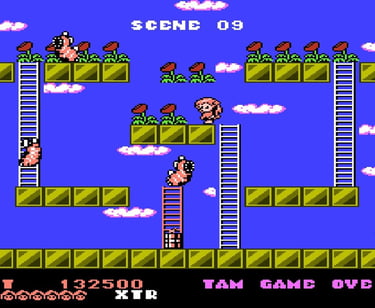

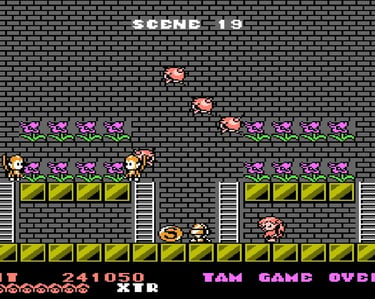


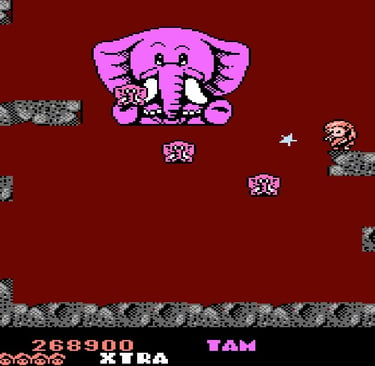

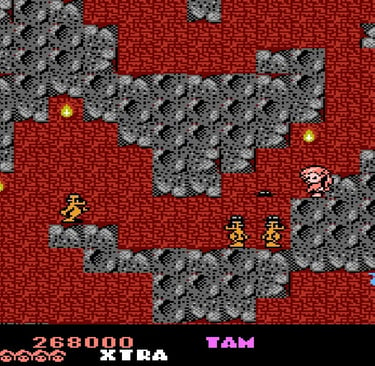
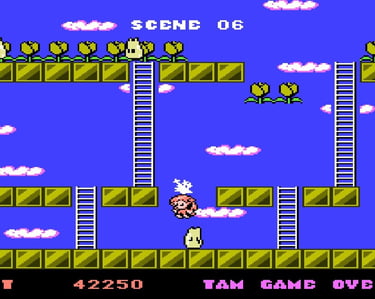

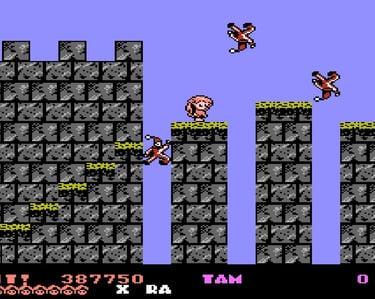

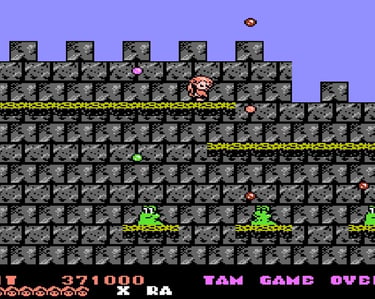

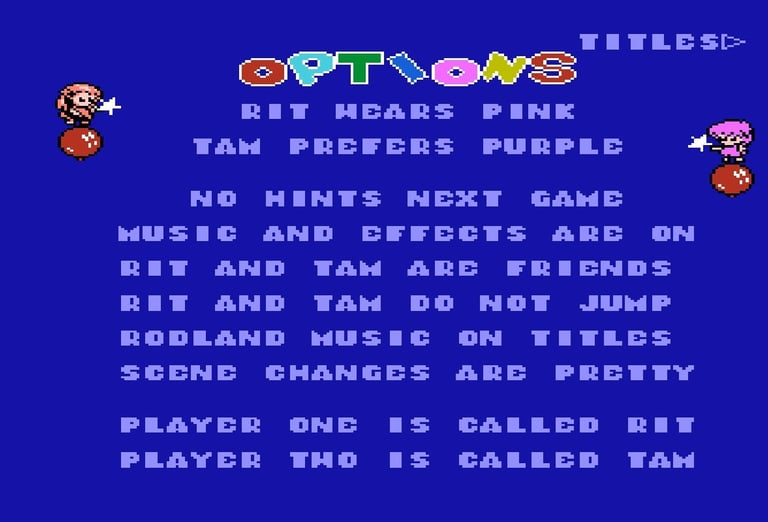

Although difficult to discern in the picture, Rit has just "stomped" that lowly Spud, stunning it temporarily. It's a feature unique to the Famicom and Game Boy versions of the title.
Boss fights take a weird turn compared to other conversions. Here, the Elephant can't be reached until Rit descends down an enormous cavern. No other version has anything resembling this odd interstitial prelude.
The final boss is also preceded by an additional stage, this one scrolling (!) left and forcing the siblings to jump--yep, jump!--to proceed.
The developer Storm always had a cheeky (or just quirky) sense of humor, as seen in the game's options screen. Oddly, it says the heroes don't jump, despite this being the only version in which they actually can.
Rod-Land
Platform: Game Boy
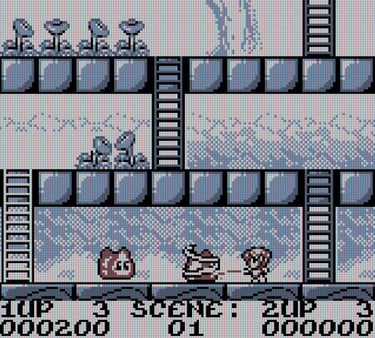

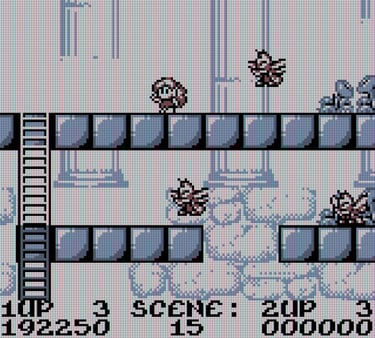

Rod-Land struggled in the arcade but found surprising success at home, running the circuit amongst a number of the era’s leading platforms. The most famous of these is likely the Amiga’s, a triumphant conversion that even trumps the arcade game by some comparisons. Less celebrated, however, are the 8-bit conversions, which can’t hope to quite capture the aesthetic charm and musical majesty offered on the greater platforms.
The Game Boy version is a case in point; if the game itself remains underappreciated in the modern age, the handheld port has been neglected entirely, lost to the greenish gray abyss of its platform’s limitations. It’s a sad fate incurred by many a Game Boy game…but not totally undeserved. With Nintendo churning out wonders like Link’s Awakening and Donkey Kong ’94 at the time, a modest game like Rod-Land could easily go unnoticed. Indeed, the game is short, easy, and doesn’t reproduce the arcade game’s experience all that accurately. And yet, it’s extremely fun.
Why? The reason, really, is speed; Game Boy Rod-Land is fast! If Rit and Tam felt rather poky in the other adaptations, they’re Olympic sprinters here. Sure, the accelerated pace undermines the “feel” of the arcade game’s more measured gameplay, but it’s also makes for an experience that’s sure to please immediately. For aggressive, even impatient players, this might be the version for them—notwithstanding the original.
The game also shares a nice feature with its Famicom (NES) counterpart: the siblings can drop atop their pursuers, stunning them temporarily for a strategic attack or retreat. But unlike that console entry, this rendition sports hand-drawn backgrounds that better convey, if vaguely, the player’s location within or outside the treacherous Maboots Tower. The portable’s music is also superior, faithfully reproducing the arcade’s whimsical tunes in the Game Boy’s intrinsic, infectious way.
But the advantages are sidelined by one major caveat—the screen scrolls. Rather than cage each stage within the meager constraints of the portable’s puny screen, the developers decided to expand the playfield beyond the visible range. This changes the strategic underpinnings of the original design, as off-screen baddies simply can’t be accounted for with any true reliability.
Not that it really matters. Again, this is still an easy game, perhaps the least challenging adaption the series has seen. With just a little effort, players will zoom to the end of the game’s forty stages with little effort…having fun, but then suddenly done with little reason to return.
And yet, for those looking for just that—a breezy, carefree dance akin to a ride or two at Disneyland—this port is the perfect one-trick ticket.--D

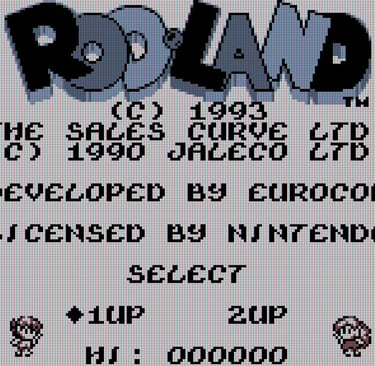


Publisher: Storm (The Sales Curve)
Developer: Jaleco/Storm
Release: 1992/93
Genre: Single-screen Platformer
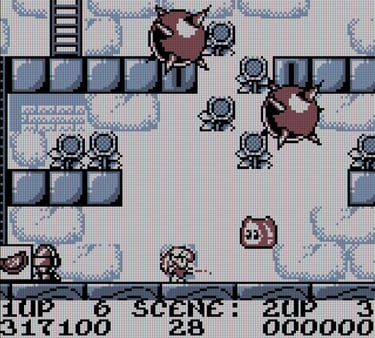



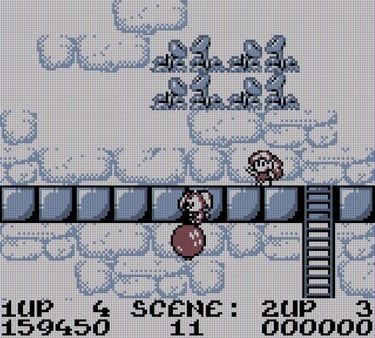

Being that the Game Boy is essentially a solo platform, the game allows players to easily choose between the two heroes, Rit and Tam. Usually, the latter is a forced player 2.
Most versions of Rod-Land don't allow attacking from mid-ladder. But in the Game Boy rendition, it's an excellent strategy.
The Game Boy's apparent screen limitations leaves this version of Rod-Land feeling a tad off-scale. Rit and Tam either seem too big or really tiny.
Despite initial appearances, the adaptation retains much of its big brothers' details, from the unique backgrounds to the quirky enemy behavior (as seen here with the bunny helping himself to a balloon ride).
Rod-Land
Platform: Commodore 64
Publisher: Storm (The Sales Curve)
Developer: Jaleco/Storm
Release: 1992/93
Genre: Single-screen Platformer
Despite its obscurity in the arcade, Rod-Land received a vast swath of home adaptions crisscrossing a variety of machines. From the Famicom to the ZX Spectrum, the game was surprisingly well represented—especially in Europe where it perhaps found its greatest following. The Amiga version is usually regarded at the superior of these many ports, even edging out the arcade original in some regards. But the hardware’s ancient cousin, that old utilitarian workhorse known as the Commodore 64, sported its own decent conversion.
It’s a strictly no-frills affair, even by 8-bit standards; both the Game Boy and Famicom renditions of the game make better first impressions. But while those conversions experiment with the basic Rod-Land formula, modifying the mechanics to sometimes produce a very different experience, the C64 version plays it straight. This is more-or-less the arcade experience, just stripped of its glorious 16-bit splendor—and thus reduced to a rudimentary take on the original game. Still fun, but lacking much of its big brother’s cartoony charm.
Fans will notice some inevitable shortcomings, of course. The backgrounds are always black canvases, offering neither context nor detail. In-game music is completely absent. And boss fights have been altered to (probably) better adapt to the hardware’s limitations. Other quirks range from baddies getting a sudden burst of speed without a flinch of warning, and using ladders as an additional way to snatch the bonus-granting flowers.
But this is, essentially, a faithful reproduction of arcade Rod-Land, right down to the 31-level structure and the ability to defeat enemies by bashing one atop the other. (Which merely stuns baddies in most other ports.) But those extra 8 bits are truly missed; without the arcade’s signature color and scintillating musical score, everything feels a little staid…bland…unmagical.
Commodore 64 fans would have been reasonably pleased with this circa 1991. But for anyone else, especially TODAY, the best Rod-Land rendition lies with the 16-bit generation.--D

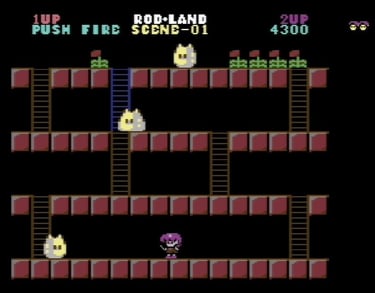
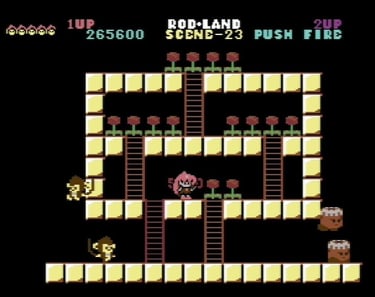

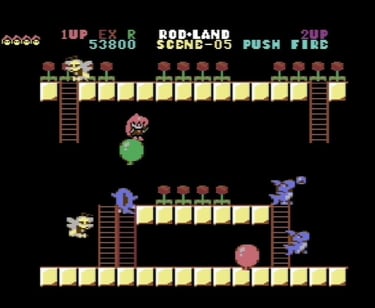

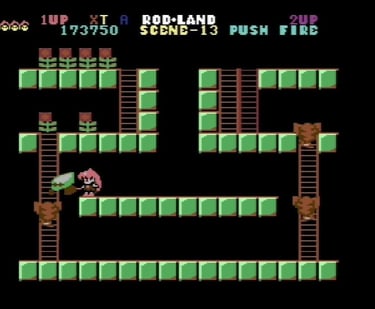

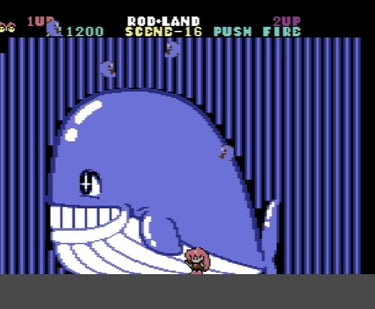

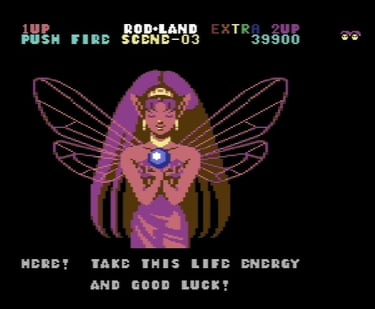

Yep, bland graphics but relatively faithful gameplay. At least Rit's C64 sprite surpasses her odd Famicom one.
The C64 version doesn't skimp on the fish!
The Commodore 64 version is also the rare home port that retains the original fairy from the arcade.
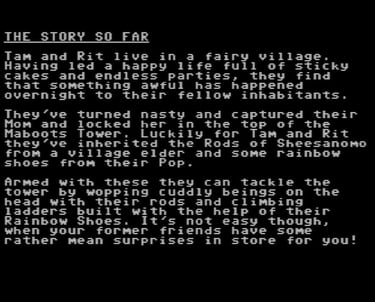

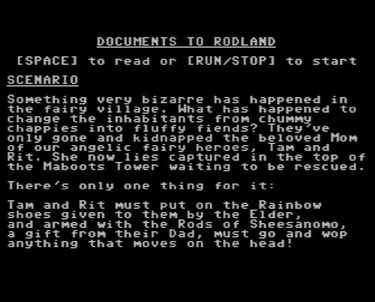

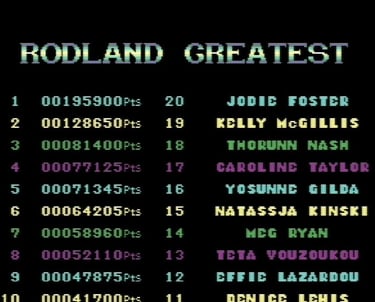

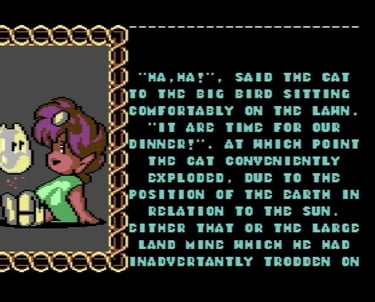

The game gives a rather involved preamble to Rit and Tam's adventure.
Again, those jokester souls at Storm have their fun, as seen in the scoreboard and final credits.
Publisher: Storm (The Sales Curve)
Developer: Jaleco/Storm
Release: 1992/93
Genre: Single-screen Platformer
Contact: lostnostalgiaproductions@gmail.com
Website: www.lostnostalgia.com
Like what we're doing? Please consider throwing us a dollar into our Patreon page's tip jar!


